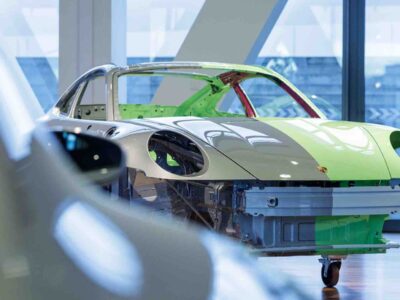(Bloomberg) —
Stay on top of the electric car revolution by signing up to our Hyperdrive newsletter here.
There is growing fear these days that the move to electric vehicles spells certain doom for a lot of low-skilled factory work. It mostly comes from the prediction, proffered by Volkswagen Chief Executive Officer Herbert Diess two years ago, that EVs will require 30% less labor than gasoline burners. He’s not alone, either.
Great change often brings pain, but how much? Certainly, the 135,000 people making engine and transmissions today are at risk. Engines require big metal castings, many more parts and much more labor to build than electric motors and batteries, said manufacturing guru Sandy Munro of Munro and Associates. Electric motors are require fewer workers and smaller factories, he said. Since those workers make up 20% of auto laborers, that’s the biggest part of what will get cut.
What about assembly workers? General Motors closed the Lordstown, Ohio assembly plant and cut or transferred more than 3,000 workers. Nearby, GM is building a battery plant that will employ one-third that at lower pay. That means assemblers are doomed, right? Not really. Lordstown was closed because the plant made small cars that are no longer popular.
Elsewhere, GM’s $30 billion push into EVs means adding assembly jobs. The auto maker will open its once-idle Detroit-Hamtramck plant next week to make the Hummer EV and Chevrolet Silverado electric pickups, plus the Cruise Origin autonomous shuttle. That plant had 1,200 workers when it was threatened with closure in 2019 — it will have double that in two years. The former Saturn plant in Spring Hill, Tenn., will be making the Cadillac Lyriq and other electric models, adding workers along the way.
All in, United Auto Workers Vice President Terry Dittes told me that the union is gaining assembly jobs as automakers prepare for a decade or more in which consumers will buy both internal combustion and electric vehicles.
At its investor presentation on Oct. 6, GM showed a graph with about 40 vehicles for sale by its four brands today, with just a couple being EVs. By 2030, the company will offer 50 models for sale and more than half will be battery-powered. GM will need workers building both of them.
There also will be opportunities for new workers with or without college degrees to work in an industry that never needed them until now. Ford and battery maker SK Innovation Co. will build three U.S. battery factories and an assembly plant, adding 11,000 workers. GM and partner LG Chem will build four battery plants, hiring 1,200 people each at its Ultium Cells LLC joint venture.
Rana Abuhashim, a young chemical engineer who grew up near Lordstown in Youngstown, was working for Goodyear Tire and Rubber in Oklahoma. She has taken her skills and returned home for a job that didn’t exist six months ago. “It brought me back to Youngstown,” she said.
It might offer something similar for lesser-skilled workers, too. Few people have experience making battery cells. GM has enlisted Youngstown State University to find and train new workers. Most of them will be younger employees who may not have college degrees, but they do have some computer and analytical skills. Ultium is not really seeking experience in physical labor.
There is a question about how much money these workers will earn. Ultium says $16 to $22 an hour. Dittes plans to try to get the UAW into the plant and raise the pay. GM won’t oppose the union, so it will become a matter of bargaining for something closer to the $32 an hour that senior union workers get now. Ford and SK will likely be in a similar situation. Even if there’s a fight about pay, the jobs will be there.
My guess: The battery plants will have to pay up with or without the UAW. There’s a worker shortage and labor has the upper hand.
To contact the author of this story:
David Welch in Southfield at dwelch12@bloomberg.net
© 2021 Bloomberg L.P.





